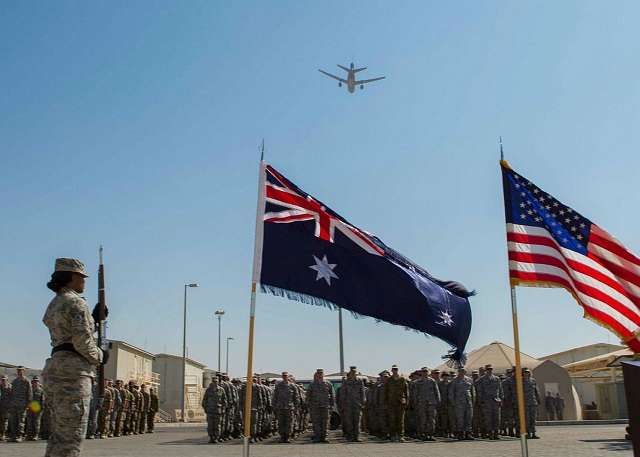
As Philippe Legrain pointed out in The Strategist last week, the election of Donald Trump as the next US president threatens to further undermine the liberal international order. Thus far, US military alliances in Asia and Europe have been a cornerstone of this structure. There’s a good chance that many of these alliances could soon be faced with a major crisis.
The success story of the North Atlantic Treaty Organization (NATO) in Europe and America’s system of bilateral alliances in Asia–Pacific has been based on three major components: a commonality of values, US leadership and credible military capabilities to deter a potential adversary. As Stephen Walt has pointed out, modern Western alliances are more likely to endure if they share similar values and when there is a large asymmetry of power within them, i.e. US leadership backed by its overwhelming military force. The commonality of values cannot be overstated. Indeed, it’s hoped that Trump’s security advisors read Geir Lundestad’s seminal article on the United States’ preeminent position during the Cold War as the reflection of an ‘empire by invitation’. Yet, it’s more likely that the Trump presidency will erode the critical ‘glue’ that holds these alliances together.
Contrary to Prime Minister Malcolm Turnbull’s views, many allies have great difficulty seeing the United States under a President Trump as the ‘leader of the free world’. America has indeed lost its status as the ‘shining city upon the hill,’ not least because of Trump’s support for authoritarianism. The unprecedented reactions from German Chancellor Angela Merkel and French president François Hollande were loud and clear: the two most important European powers condition their future relationship with Washington within NATO and elsewhere on Trump meeting the basic standards of democratic conduct. Senior German policy-makers already discuss the need for the country to prepare for a more active security and defence policy. Meanwhile, UK diplomats also fear a major diplomatic crisis because of Trump’s appetite for close ties with Vladimir Putin. Should Trump indeed pursue this option at the expense of European security concerns, other NATO allies will also look elsewhere for security.
Moreover, Trump has displayed a deep-seated belief in an isolationist foreign policy and the need for allies to pay a greater share of the burden. Indeed, no other successful presidential candidate has so frequently questioned whether the United States would defend its allies. This’s not only a problem for NATO but also for allies and partners in Asia–Pacific. Japan, South Korea and Taiwan are extremely worried about the implications of a Trump presidency. Should Trump exacerbate fears in Tokyo and Seoul about US abandonment, both could even weigh their nuclear options; Taiwan is also a ‘latent’ nuclear power.
Some commentators (here and here) argue that Trump could revitalise the pivot through building a ‘350 ship navy’ and a ‘bold’ military strategy against China. However, America’s military hardware has never been the main issue for the rebalance. Rather, the problem has been one of credible leadership ‘within’ the alliances. And Trump’s transactional understanding of alliances—the ‘more you pay, the more we protect you’—fails to understand that America’s leadership capacity and disproportionate influence has been based on its provision of significant resources. The ‘free rider’ argument is flawed in regards to most alliances. In the case of Japan, for instance, it neglects Tokyo’s significant ‘host nation’ support for US troops and the fact that its relatively low defence spending in terms of GDP (which still makes it the second most powerful navy in the region in qualitative terms) is a means to reassure neighbours about its intentions. US presence in South Korea provides Washington with significant deterrent posture vis-à-vis the nuclear regime in the North. And even in Europe, US strategic investments have delivered a return which can only partly be measured in monetary terms: broad acceptance of US transatlantic leadership but also access to critical infrastructure for global force projection, for example through bases in Germany.
Trump’s presidency could make the United States and key alliances strategically poorer. Of course, it’s still early days and the incoming administration could heed the sanguine advice by Ralph Cossa and others on how to reassure allies in Asia. Yet, in regards to Asia, David Sanger has pointed out that one of Trump’s more consistent themes is his belief that Japan has been ‘ripping off’ its US ally. Trump is also likely to pressure South Korea to increase its host nation support and to complete the transfer of operational wartime control (OPCON) to South Korean forces.
Moreover, highly institutionalised alliances such as NATO have demonstrated a remarkable resilience against shock events and strategic discontinuities. But we shouldn’t bet on it and just expect that Trump will moderate his views in office. More than anything, Trump’s pro-Russia stance as well as support for xenophobic and authoritarian positions are unlikely to subside, making cohesion within NATO a very difficult undertaking. Obama’s reassurance attempts that Trump will stick to US’ NATO commitments will hardly persuade European allies. While calls for ‘greater burden sharing’ have been repeated by almost every post-war US administration, in the context of Trump’s ideology America’s alliances could soon face a major crisis.

